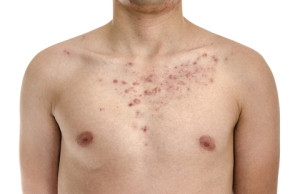 Keloids are excess scar tissue that forms on your skin at the site of an injury. Virtually any type of skin injury can lead to a keloid, including not only surgery or trauma but acne, burns, chicken pox and even ear piercing, vaccination sites and minor scratches.[i]
Keloids are excess scar tissue that forms on your skin at the site of an injury. Virtually any type of skin injury can lead to a keloid, including not only surgery or trauma but acne, burns, chicken pox and even ear piercing, vaccination sites and minor scratches.[i]
When you have a wound, your body gathers collagen around the area to help heal and seal the wound. Normally, the resulting scar will become smoother and less noticeable with time, but in the case of keloids, the scar tissue becomes overgrown, raised and extends beyond the site of the original wound. Unlike normal scars, keloids tend to enlarge over time instead of fade away.
Also unusual as far as scarring is concerned, keloids may not form for months or years after the original injury.
While anyone can develop keloids, they tend to run in families and are more common in young people (ages 10 to 20) as well as in African Americans, Asians and Hispanics. They can occur anywhere on your body, but most often appear on the shoulders, chest, back and earlobes.
Conventional Treatments May Cause More Keloids or Discoloration
A keloid may be flesh-colored, red or pink, and because they can resemble many other skin growths, a biopsy may be done to rule out another conditions. Generally, however, keloids are not dangerous (though they may be itchy or tender to the touch, and are often irritated by friction, such as contact with tight clothing).
That being said, many people would prefer to have their keloids removed because they may be disfiguring or cause some embarrassment, depending on their location and size. This presents some problems, as current treatments can be dangerous and yield less-than-desirable results. Surgery, for instance, is problematic because a new keloid may form at the site of the wound.
Injections of a chemotherapy agent or radiation have been used, but these are quite toxic for a primarily cosmetic problem. Steroid injections, laser treatments and cryotherapy (freezing) are other options, but they often leave discolorations or texture changes to your skin.[ii] As explained by William Wong, ND, PhD, member of the World Sports Medicine Hall of Fame:[iii]
“Fibrosis is the result of inflammation. Inflammation caused by the injury, by the surgery, by a burn, whatever the cause inflammation is one of two things that drive the growth of fibrosis [i.e. scar tissue] … If the inflammation can be brought under control the keloid formation might be arrested. Plastic surgeons routinely have administered local injections of cortisone in attempts to slow down the inflammation and stop the formation of keloids.
These attempts are mostly failures and if pronounced the keloid itself may have to be surgically excised, which may in turn begin the round of keloid formation all over again.”
Systemic Enzymes to Treat and Prevent Keloids
A much safer option that is standard practice in Germany for preventing scar tissue overgrowth after surgery is systemic enzymes,[iv] which both fight inflammation and eat away at the scar tissue, naturally. Dr. Wong continued:[v]
“In Germany … it was surmised by some surgeons that if the enzymes could prevent the formation of post-operative scar tissue and existing fibrosis in other conditions, that they could also lyse away [break down] the fibrosis of keloids. Their assumption was correct.
While no formal studies have yet been done on keloids specifically, the lysing action of the enzymes on other types of fibrosis has been studied and noted.
One interesting observation on the fibrosis lysing effect of systemic enzymes came from a plastic surgeon from California. This physician, while using a multi-enzyme product to reduce both the inflammation and post-operative scar tissue in his patients, was taking the product himself to lower visceral inflammation levels and bring down CRP and homocysteine levels. After several weeks on the product he reported that a 40-year-old keloid the size of a small egg that had grown on his left hand, as the result of a compound fracture, had been completely lysed away!”
Systemic enzymes have an unsurpassed ability to break down dead or foreign tissues, including scar tissue, which is why, if you have keloids, your body likely needs extra support from systemic enzymes. Systemic enzymes are naturally produced in your pancreas, but your natural production declines with age; these inflammation-busters become largely depleted as you hit 40 and over, with declines beginning in your 30s.
Replenishing your supplies is easy with Heal-n-Soothe, the best systemic enzyme formula to replenish your body’s supply of vital enzymes. Heal-n-Soothe®” gives you the healing power of systemic enzymes in a convenient capsule … and it may also give you back your confidence once your keloids completely disappear.
[iii] SystemicEnzymes.net The Cure for Keloids Old and New




Hi
I have killoids on my shoulders and two others have recently appear. The reason may be acne but I have not idea where and why this comes from and I am desperate to try any non intrusive treatment.
Could you please give me information about your product>
Thanks
I have uterine fibroids, which, I feel, developed after I had a curette. is this likely a keloid development? and would Heal’n’soothe assist in the reduction of size of the fibroids?
Maree, Please understand we are not doctors and can not comment on your current medical situation. The only way to get this question answered is to go and get a proper medical evaluation.
That said, the enzymes in Heal n Soothe can help breakdown and remove excess fibrin in your body.
You are welcome to call our office and ask for the Free Trial Offer, 1-800-216-4908 9 to 4 EST.
Thanks
Steve HBI-Staff